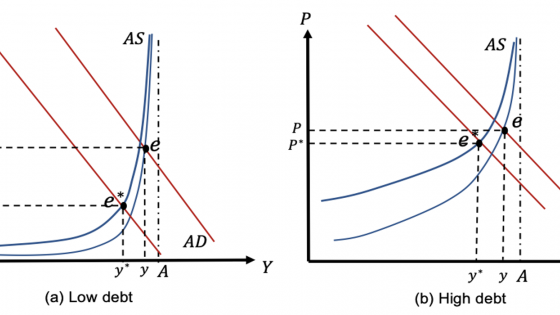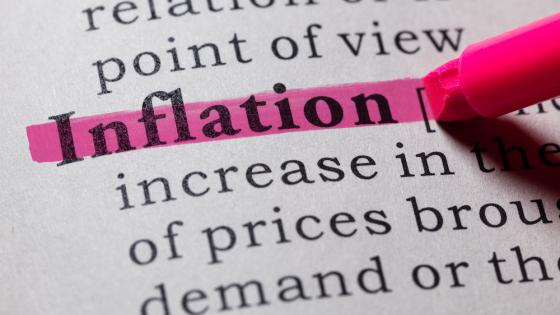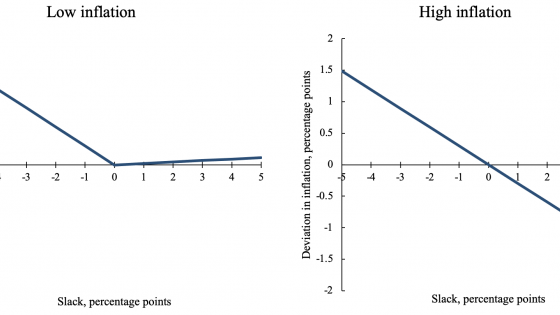Nominal interest rates in many countries, particularly in the main advanced economies, have been persistently low for more than a decade now, at levels never seen before in history. In some jurisdictions, policy rates have even been in negative territory for several years. Yet, despite these very low rates and aggressive monetary policy easing, the strength of the economy since the Great Financial Crisis (GFC) has been, on balance, disappointing while inflation has tended to languish below target. Only now, driven by supply bottlenecks and large spikes in commodity prices, has inflation re-emerged with a vengeance. Is it possible that one reason why interest rates have fallen so low and central bank balance sheets have grown so much is that the impact of monetary policy on economic activity has waned as interest rates have declined?
The question of the seemingly smaller traction of monetary policy on inflation has received a lot of attention. But much of the work has focused on the reduced policy space implied by a fall in the equilibrium real interest rate (e.g. Hofmann et al. 2021) and the flattening of the Phillips curve (e.g. Del Negro et al 2020).1 Hardly any analysis has evaluated the possibility that aggregate demand may have become less responsive to monetary policy easing. In other words, the IS curve may have steepened – a hypothesis laid out in Borio and Hofmann (2017). There are many potential explanations, not least headwinds linked to the need to work off the post-GFC debt overhang. A more troubling possibility, though, is that the low interest rate environment itself may be partly responsible. In a recent paper (Ahmed et al. 2021), we explore this hypothesis.
Why could low rates sap monetary policy traction?
Conceptually, there are several channels through which persistently low interest rates could diminish the traction of monetary policy on economic activity.
First, low nominal interest rates can harm bank profitability. To the extent that lower bank profitability inhibits loan supply, the negative effect of lower rates on banks’ net interest margins can even give rise to a 'reversal interest rate', whereby accommodative monetary policy becomes contractionary (Brunnermeier and Koby 2018).
Second, as interest rates fall towards the zero lower bound, market expectations of further potential rate cuts are commensurately reduced. This can attenuate the signalling power of monetary accommodation.
Third, persistently low rates may create disincentives to address debt overhangs, undermining efficient resource allocation and productivity. The rise of 'zombie firms' is one such manifestation (Acharya et al. 2020, Banerjee and Hofmann 2020).
Last but not least, the effects of real interest rates on consumption and investment could be non-linear for a variety of reasons. For consumption, positive intertemporal substitution effects may be offset by negative income effects, which encourage saving (van den End et al. 2020). For investment, to the extent that firms’ hurdle rates of return are sticky, additional reductions in funding costs will have little effect once profitable projects have been exhausted. More generally, there are surely limits to the extent to which lower interest rates can bring forward consumption, and hence investment, from the future. To the extent that low nominal rates come along with low real rates or if economic agents suffer from ‘money illusion’, the non-linearity in the effects of real rates would also be reflected in the effects of nominal rates.
Low rates versus debt overhangs and recessions
We test the role of low rates in steepening the IS curve for a panel of 18 advanced economies over the period 1985Q1–2019Q4 – a period spanning both the Great Moderation and the post-GFC recovery. We estimate the transmission of monetary policy to the real economy using a local projection approach, identifying monetary policy shocks through the inclusion of appropriate control variables, akin to a recursive scheme in a vector autoregressive model.
In a linear model that disregards any possible changes linked to low rates or other factors, a 100 basis point cut in the policy rate boosts real GDP by up to 0.5% (Figure 1, left-hand panel). The impact, however, is not constant over time. Splitting the sample into pre- and post-GFC periods reveals that the impact of monetary policy is substantially smaller post-GFC (Figure 1, right-hand panel). Over this period, the output boost after six quarters drops by over two thirds and is much less persistent.
Figure 1 Response to monetary stimulus: Linear baseline (%)
Note: Impulse responses with 90% confidence bands of real GDP to a 100 bps expansionary monetary policy shock.
Source: BIS calculations.
What explains this drop in monetary policy traction? The period saw low interest rates, debt overhangs, and, in many countries, phases of recession. All three factors may have sapped monetary policy traction. In order to test their respective roles, we allow for non-linearities in the local projection model, so that the impact of monetary policy on real GDP can vary depending on the interest rate, debt and business cycle regimes. We identify high and low interest rate regimes using a data-driven approach (grid search), which sets the interest rate threshold at 2.25%. We identify a high-debt regime as one where the gap between the household debt-to-GDP ratio and its long-term trend (credit gap) is in the top 25th percentile of its distribution. We identify recessions based on the OECD classification.
We first consider the regime for each variable taken individually. We confirm previous results indicating that the traction of monetary policy is weaker when debt is high (Alpanda and Zubairy 2019) and during economic downturns (Tenreyro and Thwaites 2016) (Figure 2, middle and right-hand panels). The same is true when interest rates are low (left-hand panel) – a result that echoes the recent findings by van den End et al. (2020).
Figure 2 Regime-dependent responses to monetary policy stimulus (%)
Note: Impulse responses with 90% confidence bands of real GDP to a 100 bps expansionary monetary policy shock.
Source: BIS calculations.
But how much does the finding concerning low interest rates simply reflect their correlation with debt and the state of the business cycle? After all, high-debt, recession and low-rate regimes often overlapped over our sample period.
Once we include the various regimes jointly, thereby essentially running a horse race between them, we find that low interest rates matter in themselves also after taking into account the effects on monetary policy traction of high debt and recessions (Figure 3). The low-rate interaction coefficient remains negative and statistically significant at almost all horizons (left-hand panel). And while the dampening effects of high debt and business cycle downturns continue to be present, they are statistically significant only at longer horizons (middle and right-hand panels).2
Figure 3 Low rates, high debt, recession and the traction of monetary policy (percentage points)
Note: Estimates with 90% confidence bands of the interaction coefficients of the low-interest rate regime indicator, the high-debt regime indicator and the recession indicator with the monetary policy shock, respectively. All three regimes are included in the regression jointly. A negative interaction coefficient x indicates that the positive effect of an expansionary monetary policy shock on real GDP is reduced by x percentage points.
Source: BIS calculations.
Low for long
Many of the mechanisms through which low rates deplete monetary policy traction suggest that the attenuation effect becomes stronger the longer rates stay low. For example, the extent to which low rates sap bank profitability and hence capital levels depends on how long net interest margins remain under pressure. Likewise, as debt burdens build up over time, the headwinds they generate will be greater the longer the low rates have contributed to debt accumulation.
To assess the impact of ‘low for long’ (LFL), we construct a variable that captures how many quarters a country remains in a low interest rate regime, in the spirit of Claessens et al. (2018). The indicator is constructed so that the marginal effect of the impact of low rates declines over time (log transformation). That is, adding one more quarter reduces traction, but this effect declines with each additional quarter.
The estimation results suggest that LFL indeed saps the strength of monetary transmission at all horizons, and especially at longer ones. To fix ideas, if interest rates stay below the low-rate threshold of 2.25% for 16 quarters (LFL=16), the impact of a 100 basis point interest rate cut on real GDP is about 0.6 percentage points lower than if they had not breached that threshold (Figure 4).
Figure 4 Low for long (LFL) reduces the traction of monetary policy
Notes: Impulse responses with 90% confidence bands of real GDP to a 100 bps expansionary monetary policy shock when the interest rate has not been low (LFL=0) and when it has been low for 16 quarters (LFL=16).\
Source: BIS calculations.
Conclusions
It is well known that persistently low interest rates can raise important challenges for monetary policy. These are primarily intertemporal in nature. Necessary as they may be to support aggregate demand and boost inflation in the near term, persistently low rates give rise to risks for long-term macroeconomic resilience and stability.
Our findings shed further light on these challenges. It is not just a flattening of the Phillips curve that may have exacerbated them; a steepening of the IS curve linked to the prevailing low interest rate environment may also have played a role. The findings, if correct, put a premium on flexibility in the pursuit of tightly defined inflation targets under those circumstances. Lengthening the policy horizon can be very useful in this respect.
Would it be reasonable to infer that a tightening of policy at low rates would also have a smaller impact on activity? This is especially relevant now, as central banks are normalising policy in response to the surprising flare-up of inflation. We would argue that this inference is not justified. The sample over which we carried out our analysis covers overwhelmingly an easing phase, so we could not properly test for asymmetries. In fact, there are reasons to believe that the impact could be as large, if not larger, than outside low interest rate regimes. This would reflect the increase in indebtedness and aggressive risk-taking that goes hand in hand with interest rates that are unusually low for unusually long. Time will tell.
Author’s note: The views expressed are our own and do not necessarily reflect those of the Bank for International Settlements, the Bank of Thailand or the US Department of the Treasury.
References
Acharya, V, T Eisert, C Eufinger and C Hirsch (2020), “Zombie credit and (dis-) inflation: Evidence from Europe”, Federal Reserve Bank of New York Staff Reports No. 955.
Ahmed, R, C Borio, P Disyatat and B Hofmann (2021), “Losing traction? The real effects of monetary policy when interest rates are low”, BIS Working Papers No 983.
Alpanda, S and S Zubairy (2019), “Household debt overhang and the transmission of monetary policy”, Journal of Money, Credit and Banking 51(5): 1265–307.
Banerjee, R and B Hofmann (2020), “Corporate zombies: Anatomy and life cycle”, BIS Working Papers No. 882.
Borio, C, P Disyatat, D Xia and E Zakrajšek (2022), “Looking under the hood: the two faces of inflation”, VoxEU.org, 25 January.
Borio, C and B Hofmann (2017), “Is monetary policy less effective when interest rates are persistently low?”, BIS Working Papers no 628.
Brunnermeier, M and Y Koby (2018), “The reversal interest rate”, NBER Working Paper No. 25406.
Claessens, S, N Coleman and M Donnelly (2018), ”’Low-For-Long’ interest rates and banks’ interest margins and profitability: Cross-country evidence”, Journal of Financial Intermediation 35(Part A): 1–16.
Del Negro, M, M Lenza, G Primiceri and A Tambalotti (2020), “What’s up with the Phillips Curve?”, Brookings Papers on Economic Activity, Spring: 301–73.
Hofmann, B, M Lombardi, B Mojon and A Orphanides (2021), “Fiscal and monetary policy interactions in a low interest rate world”, BIS Working Papers No. 954.
Tenreyro, S and G Thwaites (2016), “Pushing on a string: US monetary policy is less powerful in recessions”, American Economic Journal: Macroeconomics 8(4): 43–74.
van den End, J W, P Konietschke, A Samarina and I Stanga (2020), “Macroeconomic reversal rate: Evidence from a nonlinear IS-Curve”, De Nederlandsche Bank Working Paper No. 684.
Endnotes
1 Similarly, based on an analysis of highly disaggregated data, Borio et al (2022) find that, when low inflation becomes entrenched, the impact of monetary policy on inflation declines, not least because inflation largely reflects idiosyncratic price changes rather than changes in their common component.
2 In the working paper (Ahmed et al. 2021), we show that all of these results hold in a number of robustness checks. One important such check is controlling for the possible trend decline in equilibrium interest rates through country-specific smooth real interest rate trends.
3 We also tried a simple linear-count specification of the low-for-long variable, which turned out to be insignificant for most of the horizons. This suggests that the data are more consistent with the log-count specification.











